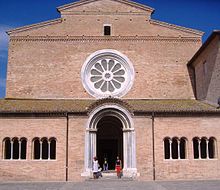- Chiaravalle Abbey, Fiastra
-
Chiaravalle Abbey, Fiastra (Italian: Abbazia di Chiaravalle di Fiastra) is a Cistercian abbey situated between Tolentino and Urbisaglia, in the Marche. It is one of the best preserved Cistercian abbeys in Italy. It is surrounded by a large nature reserve.
Contents
History
In 1142 Guarnerio II, Duke of Spoleto and Marquis of the March of Ancona, gave the Cistercians a large area of land which stretched from the river Chienti to the river Fiastra. The monks, from Chiaravalle Abbey in Milan, arrived on 29 November of the same year and immediately started work on the construction of the monastery. They used material from the ruins of the nearby Roman town of Urbs Salvia, destroyed by Alaric in 408-410. They also began reclaiming the marshy woodland, inhabited by wolves, bears and deer.
The abbey flourished for three centuries. The monks organized their agricultural land into six granges. The monastery was actively involved in encouraging the economic, social and religious development of the area. Its influence grew to the extent that it incorporated 33 dependent churches and monasteries. The history of the abbey is recorded in the collection of 3,194 manuscripts known as the Carte Fiastrensi, now in the state archive of Rome.
In 1422 the abbey was sacked by Braccio da Montone, who destroyed the roof of the church and the tiburio (the high bell tower), and killed a number of the monks.
Subsequently, the Pope entrusted the abbey to a group of eight cardinals.
In 1581, the abbey was assigned to the Jesuits. Finally, in 1773, after the suppression of the Jesuits, the whole area was handed over to the noble Bandini family. The last heir of the family, Sigismondo, left the area to the present Giustiniani-Bandini Foundation, who set up the Fiastra Abbey Nature Reserve in order to preserve this heritage. The Reserve, opened on 18 June 1984, was officially recognized by the State on 10 December 1985, as being of national importance.
Present-day
Church
The church is dedicated to Santa Maria di Chiaravalle di Fiastra. The imposing building is pure Cistercian architecture, typical of the transitional phase between the Romanesque and the Gothic. There are three naves, and eight bays with Romanesque arches; the capitals of the columns were carved by the monks themselves.
Monastery
The monastery, which is next to the church, still functions as a Cistercian community. It boasts a beautiful cloister rebuilt in the 15th century. All around the cloister, it is possible to see the lay brothers' refectory, the cellar, the chapter house and the grottoes.
See also
- Urbisaglia
- Archaeological Park of Urbs Salvia
External links
- Riserva Naturale Abbadia di Fiastra (Italian)
Categories:- Christian monastery stubs
- Italian church stubs
- Romanesque architecture in Italy
- Cistercian monasteries in Italy
Wikimedia Foundation. 2010.


